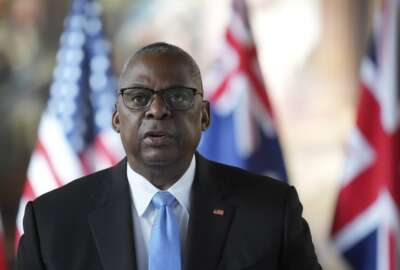Tighter budget inspires services to rethink their workforce
With less money to work with, the military services has to think creatively in order to deploy its shrinking workforce.
wfedstaff | June 4, 2015 6:56 pm
Tighter budgets are forcing agencies all over government to rethink their workforces. That includes the military services which are moving people and jobs around to address changing times.
“We’re moving sailors from desk jobs to the pier,” said Navy Secretary Ray Mabus. “About 2,000 sailors are going back to the piers just to do maintenance and things like that that have been suffering in the past.”
At the same time, the Marines Corps is shrinking its workforce from 202,000 to 182,100.
“If you look at the composition of the Marine Corps that will be there in four years, it’s going to be a different composition,” Mabus said. “We’re going to have more people in cyber, more people in special operations, special operation enablers and things like that.”
Advances in technology are also enabling the Navy to better deploy its manpower. Ships that 40 years ago required a sailor for every valve that needed to be turned can now be manned by a much smaller crew.
“That’s one side of the coin,” Mabus said. “On the other side, those sailors that we do have have to be really good at what they do, and they have to be really versatile in the number of things they’re able to do.”
In the 1990s, the Defense Department faced a post-Cold War drawdown, resulting across-the-board cuts. At that time, the Navy saw significant cuts to its acquisition workforce. According to the Mabus, the Navy has hired significant numbers of new acquisition professionals.
“It’s one of the exceptions we’ve made to bringing people in,” he said. “In all, when we’re through, we’re going to bring in about 5,000 acquisition professionals. We’re over halfway there.”
According to David Van Buren, Air Force Service Acquisition executive, his service has been addressing the workforce issue for two or three years.
“When you have a ramp up of the overall budget, you sometimes find inefficiencies,” Van Buren said. “It’s important to always look at that and find out what you can do with that.”
For Van Buren, the focus should be on competency and not numbers. “There’s plenty enough people,” he said. “Let’s focus on getting them trained and giving them all the skill set to balance their God-given capabilities.”
The Air Force has been accomplishing that through the Defense Acquisition University and its own internal training activities.
RELATED STORIES:
Tighter budgets mean armed forces need to work together
Copyright © 2024 Federal News Network. All rights reserved. This website is not intended for users located within the European Economic Area.
Michael O’Connell is senior digital editor of Federal News Network optimizing content for the best user experience. Follow @moconnellWFED
Follow @moconnellWFED






